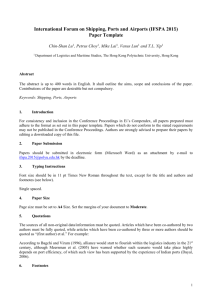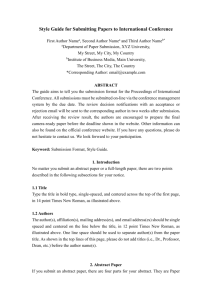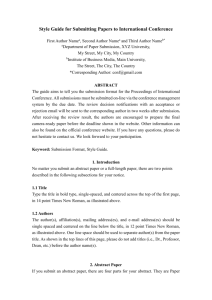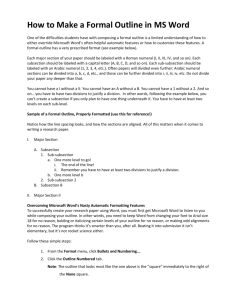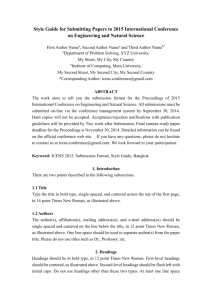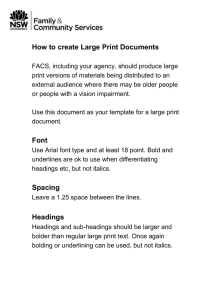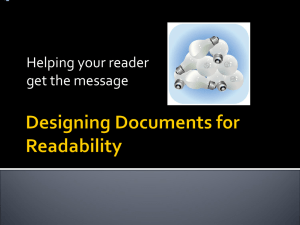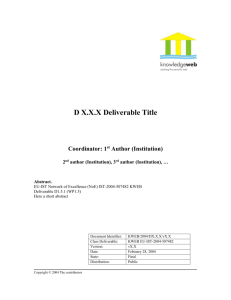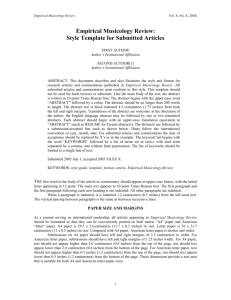Typing Instructions For IEEE SMC`05 Paper Submissions
advertisement
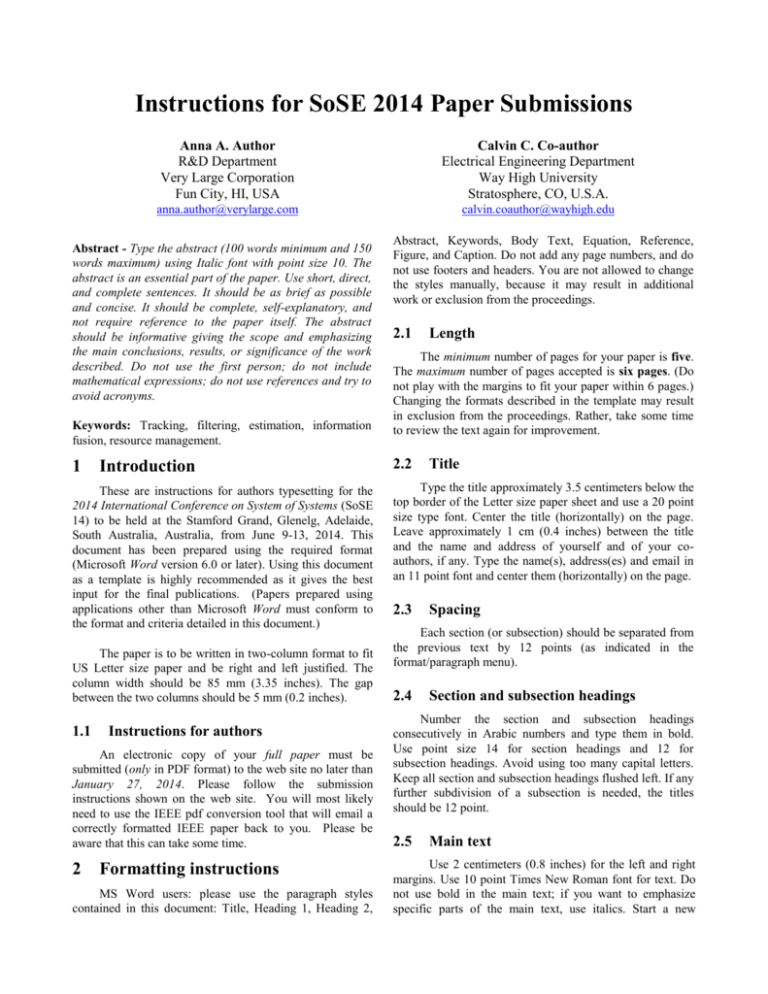
Instructions for SoSE 2014 Paper Submissions Anna A. Author R&D Department Very Large Corporation Fun City, HI, USA Calvin C. Co-author Electrical Engineering Department Way High University Stratosphere, CO, U.S.A. anna.author@verylarge.com calvin.coauthor@wayhigh.edu Abstract - Type the abstract (100 words minimum and 150 words maximum) using Italic font with point size 10. The abstract is an essential part of the paper. Use short, direct, and complete sentences. It should be as brief as possible and concise. It should be complete, self-explanatory, and not require reference to the paper itself. The abstract should be informative giving the scope and emphasizing the main conclusions, results, or significance of the work described. Do not use the first person; do not include mathematical expressions; do not use references and try to avoid acronyms. Keywords: Tracking, filtering, estimation, information fusion, resource management. 1 Introduction These are instructions for authors typesetting for the 2014 International Conference on System of Systems (SoSE 14) to be held at the Stamford Grand, Glenelg, Adelaide, South Australia, Australia, from June 9-13, 2014. This document has been prepared using the required format (Microsoft Word version 6.0 or later). Using this document as a template is highly recommended as it gives the best input for the final publications. (Papers prepared using applications other than Microsoft Word must conform to the format and criteria detailed in this document.) The paper is to be written in two-column format to fit US Letter size paper and be right and left justified. The column width should be 85 mm (3.35 inches). The gap between the two columns should be 5 mm (0.2 inches). 1.1 Instructions for authors An electronic copy of your full paper must be submitted (only in PDF format) to the web site no later than January 27, 2014. Please follow the submission instructions shown on the web site. You will most likely need to use the IEEE pdf conversion tool that will email a correctly formatted IEEE paper back to you. Please be aware that this can take some time. 2 Formatting instructions MS Word users: please use the paragraph styles contained in this document: Title, Heading 1, Heading 2, Abstract, Keywords, Body Text, Equation, Reference, Figure, and Caption. Do not add any page numbers, and do not use footers and headers. You are not allowed to change the styles manually, because it may result in additional work or exclusion from the proceedings. 2.1 Length The minimum number of pages for your paper is five. The maximum number of pages accepted is six pages. (Do not play with the margins to fit your paper within 6 pages.) Changing the formats described in the template may result in exclusion from the proceedings. Rather, take some time to review the text again for improvement. 2.2 Title Type the title approximately 3.5 centimeters below the top border of the Letter size paper sheet and use a 20 point size type font. Center the title (horizontally) on the page. Leave approximately 1 cm (0.4 inches) between the title and the name and address of yourself and of your coauthors, if any. Type the name(s), address(es) and email in an 11 point font and center them (horizontally) on the page. 2.3 Spacing Each section (or subsection) should be separated from the previous text by 12 points (as indicated in the format/paragraph menu). 2.4 Section and subsection headings Number the section and subsection headings consecutively in Arabic numbers and type them in bold. Use point size 14 for section headings and 12 for subsection headings. Avoid using too many capital letters. Keep all section and subsection headings flushed left. If any further subdivision of a subsection is needed, the titles should be 12 point. 2.5 Main text Use 2 centimeters (0.8 inches) for the left and right margins. Use 10 point Times New Roman font for text. Do not use bold in the main text; if you want to emphasize specific parts of the main text, use italics. Start a new paragraph by indenting it from the left margin (and not by inserting a blank line). Leave a margin of at least 2 centimeters (0.8 inches) at the page head (for our placement of the final numbers and running heads). The typing area should not exceed 24 x 17.5 centimeters (9.4 x 6.9 inches). The text should be prepared with a double column format and single line spacing. 2.6 Tables All tables must be embedded in your document. They must be numbered consecutively (in Arabic numbers). Table headings should be placed (centered) above the table. Place tables as close as possible to where they are mentioned in the main text. 2.7 2.10 Fine tuning Figures All illustrations should be embedded scans of original drawings or photographic prints of originals. All figures must be embedded in your document. All illustrations must be numbered consecutively (i.e., not section-wise), using Arabic numbers. Center figure captions beneath the figure (see Figure 1). If possible, do not assemble figures at the back of your article, but place them as close as possible to where they are mentioned in the main text. No part of a figure should go beyond the typing area. Figure captions should appear (centered) below graphical objects, as in Figure 1. 3 Do not end a page with a section or subsection heading. Keep footnotes to a minimum. Do not use footers and headers. Do not include page numbers in the text (this is our job). Conclusions This sample paper presents the formatting instructions for preliminary and final camera-ready paper submissions to SoSE 2014. Please address any problems related to use of this template to the Publication Chair at the following address: Dr Tim Ferris Timothy.Ferris@unisa.edu.au References [1] A.A. Author, “My best paper yet,” Proc. Best Conference in the World, Best City, pp. 11-18, March 2001. [2] B.B. Coauthor and A. Friend, “Boris’s favorite journal paper,” A really great journal, Vol 37, No. 3, pp. 433-448, Feb. 2000. [3] Nobel Laureate, His book, Publisher, Location, Year. Figure 1. Fusion data flow 2.8 Mathematical formulas Mathematical formulas should be roughly centered and numbered, as in: y f (x) 2.9 (1) References References to the literature should be mentioned in the main text by an Arabic number in square brackets, like [1], [2]. List these in order of appearance at the very end of your paper (under the heading References). Start each reference on a new line with its number in square brackets [3]. Number footnotes separately in superscripts. Place the actual footnote at the bottom of the column in which it was cited. Do not use footnotes in the reference list.

